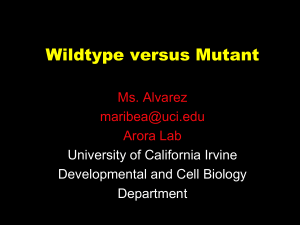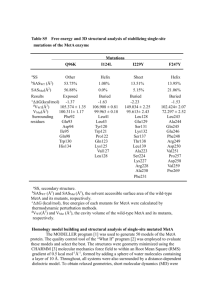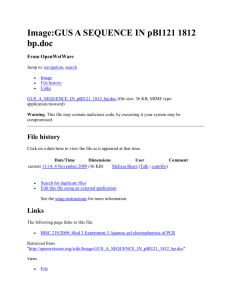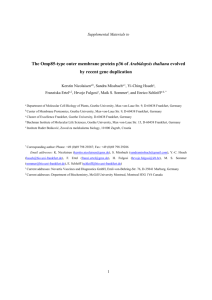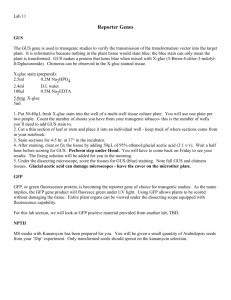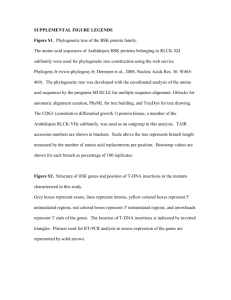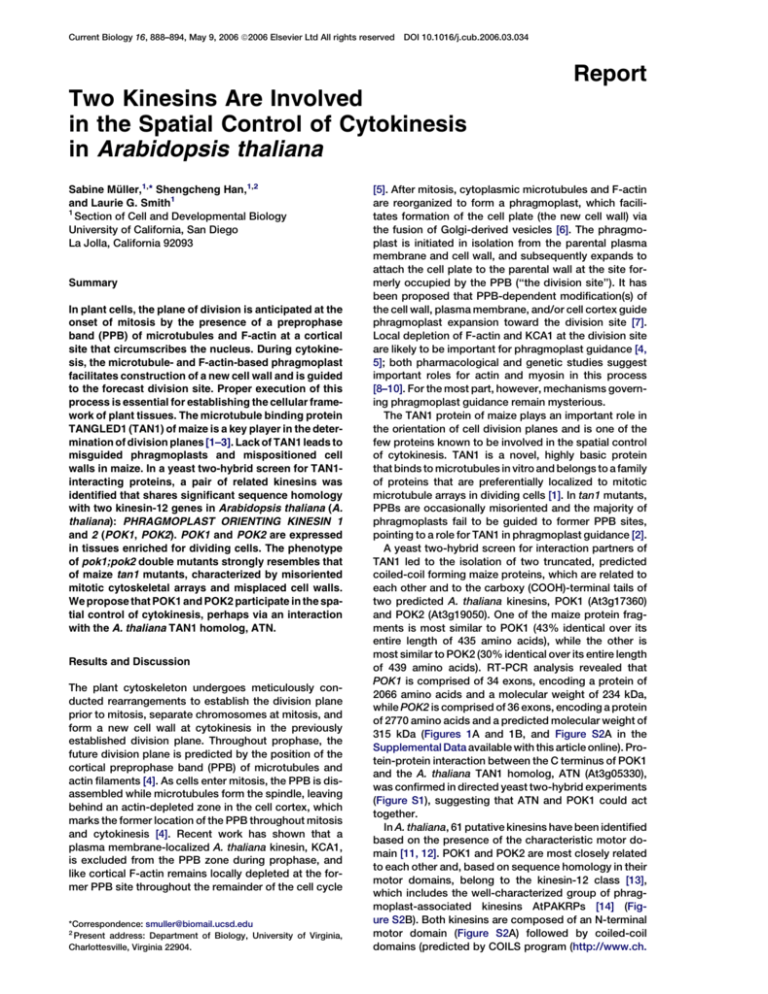
Current Biology 16, 888–894, May 9, 2006 ª2006 Elsevier Ltd All rights reserved
DOI 10.1016/j.cub.2006.03.034
Report
Two Kinesins Are Involved
in the Spatial Control of Cytokinesis
in Arabidopsis thaliana
Sabine Müller,1,* Shengcheng Han,1,2
and Laurie G. Smith1
1
Section of Cell and Developmental Biology
University of California, San Diego
La Jolla, California 92093
Summary
In plant cells, the plane of division is anticipated at the
onset of mitosis by the presence of a preprophase
band (PPB) of microtubules and F-actin at a cortical
site that circumscribes the nucleus. During cytokinesis, the microtubule- and F-actin-based phragmoplast
facilitates construction of a new cell wall and is guided
to the forecast division site. Proper execution of this
process is essential for establishing the cellular framework of plant tissues. The microtubule binding protein
TANGLED1 (TAN1) of maize is a key player in the determination of division planes [1–3]. Lack of TAN1 leads to
misguided phragmoplasts and mispositioned cell
walls in maize. In a yeast two-hybrid screen for TAN1interacting proteins, a pair of related kinesins was
identified that shares significant sequence homology
with two kinesin-12 genes in Arabidopsis thaliana (A.
thaliana): PHRAGMOPLAST ORIENTING KINESIN 1
and 2 (POK1, POK2). POK1 and POK2 are expressed
in tissues enriched for dividing cells. The phenotype
of pok1;pok2 double mutants strongly resembles that
of maize tan1 mutants, characterized by misoriented
mitotic cytoskeletal arrays and misplaced cell walls.
We propose that POK1 and POK2 participate in the spatial control of cytokinesis, perhaps via an interaction
with the A. thaliana TAN1 homolog, ATN.
Results and Discussion
The plant cytoskeleton undergoes meticulously conducted rearrangements to establish the division plane
prior to mitosis, separate chromosomes at mitosis, and
form a new cell wall at cytokinesis in the previously
established division plane. Throughout prophase, the
future division plane is predicted by the position of the
cortical preprophase band (PPB) of microtubules and
actin filaments [4]. As cells enter mitosis, the PPB is disassembled while microtubules form the spindle, leaving
behind an actin-depleted zone in the cell cortex, which
marks the former location of the PPB throughout mitosis
and cytokinesis [4]. Recent work has shown that a
plasma membrane-localized A. thaliana kinesin, KCA1,
is excluded from the PPB zone during prophase, and
like cortical F-actin remains locally depleted at the former PPB site throughout the remainder of the cell cycle
*Correspondence: smuller@biomail.ucsd.edu
2
Present address: Department of Biology, University of Virginia,
Charlottesville, Virginia 22904.
[5]. After mitosis, cytoplasmic microtubules and F-actin
are reorganized to form a phragmoplast, which facilitates formation of the cell plate (the new cell wall) via
the fusion of Golgi-derived vesicles [6]. The phragmoplast is initiated in isolation from the parental plasma
membrane and cell wall, and subsequently expands to
attach the cell plate to the parental wall at the site formerly occupied by the PPB (‘‘the division site’’). It has
been proposed that PPB-dependent modification(s) of
the cell wall, plasma membrane, and/or cell cortex guide
phragmoplast expansion toward the division site [7].
Local depletion of F-actin and KCA1 at the division site
are likely to be important for phragmoplast guidance [4,
5]; both pharmacological and genetic studies suggest
important roles for actin and myosin in this process
[8–10]. For the most part, however, mechanisms governing phragmoplast guidance remain mysterious.
The TAN1 protein of maize plays an important role in
the orientation of cell division planes and is one of the
few proteins known to be involved in the spatial control
of cytokinesis. TAN1 is a novel, highly basic protein
that binds to microtubules in vitro and belongs to a family
of proteins that are preferentially localized to mitotic
microtubule arrays in dividing cells [1]. In tan1 mutants,
PPBs are occasionally misoriented and the majority of
phragmoplasts fail to be guided to former PPB sites,
pointing to a role for TAN1 in phragmoplast guidance [2].
A yeast two-hybrid screen for interaction partners of
TAN1 led to the isolation of two truncated, predicted
coiled-coil forming maize proteins, which are related to
each other and to the carboxy (COOH)-terminal tails of
two predicted A. thaliana kinesins, POK1 (At3g17360)
and POK2 (At3g19050). One of the maize protein fragments is most similar to POK1 (43% identical over its
entire length of 435 amino acids), while the other is
most similar to POK2 (30% identical over its entire length
of 439 amino acids). RT-PCR analysis revealed that
POK1 is comprised of 34 exons, encoding a protein of
2066 amino acids and a molecular weight of 234 kDa,
while POK2 is comprised of 36 exons, encoding a protein
of 2770 amino acids and a predicted molecular weight of
315 kDa (Figures 1A and 1B, and Figure S2A in the
Supplemental Data available with this article online). Protein-protein interaction between the C terminus of POK1
and the A. thaliana TAN1 homolog, ATN (At3g05330),
was confirmed in directed yeast two-hybrid experiments
(Figure S1), suggesting that ATN and POK1 could act
together.
In A. thaliana, 61 putative kinesins have been identified
based on the presence of the characteristic motor domain [11, 12]. POK1 and POK2 are most closely related
to each other and, based on sequence homology in their
motor domains, belong to the kinesin-12 class [13],
which includes the well-characterized group of phragmoplast-associated kinesins AtPAKRPs [14] (Figure S2B). Both kinesins are composed of an N-terminal
motor domain (Figure S2A) followed by coiled-coil
domains (predicted by COILS program (http://www.ch.
Kinesins in Plant Cytokinesis
889
Figure 1. POK1 and POK2 Gene Structure and Mutations
(A) Exon/intron structure of POK1 showing the locations of T-DNA insertions in pok1-1 (exon 15) and pok1-2 (exon 7) alleles.
(B) Exon/intron structure of POK2 showing the locations of T-DNA insertions in pok2-1 (exon 28) and pok2-2 (exon 23) alleles. Exons are shown as
black bars, introns are shown as lines. The complete coding sequence for each gene was determined by RT-PCR analysis, by means of primers
listed in Table S2.
(C) Northern blot analysis of POK1 gene expression in wild-type (Columbia), pok1-1 and pok1-2 mutant backgrounds. The POK1 probe (located
as illustrated in [A]) was PCR amplified with primers POK1-XbaI/NruIF and POK1-SpeIR (Table S2) from wild-type cDNA obtained via reverse
transcription of flower bud RNA with a Retroscript Kit (Ambion, Austin, TX). The UBQ5 cDNA fragment used to demonstrate equal loading
was amplified from flower bud cDNA with primers NUBQ5 and CUBQ (Table S2). For Northern blot analysis, RNA was extracted from flower
buds (all stages) with Trizol (Invitrogen, Carlsbad, CA) according to manufacturer’s specifications. mRNA was isolated with PolyATtract
mRNA isolation system (Promega, Madison, WI). 2 mg of mRNA was loaded in each lane. Probes were labeled with 32P-dCTP with a Prime-It
Kit (Stratagene, Carlsbad, CA) and used for Northern blotting as described previously [1].
(D) RT-PCR analysis of POK2 gene expression in wild-type (Columbia), pok2-1 and pok2-2 mutant backgrounds (N, no DNA negative control; G,
wild-type genomic DNA positive control). PCR was performed with 1 ml of undiluted cDNA (und.) and 1 ml of 1:10 diluted cDNA (1:10) as templates.
Primer pairs were chosen to flank T-DNA insertion sites in each pok2 allele (see Table S2) amplifying PCR fragments a (for pok2-2 analysis) and
b (for pok2-1 analysis), whose locations are illustrated in (B). As a control, a fragment of the UBQ5 gene was amplified from each template with
NUBQ5 and CUBQ5 primers (Table S2). For cDNA production, 2 mg of total RNA from 6 day-old seedlings (isolated as described earlier) was
treated with DNase (Invitrogen) and reverse transcribed as described earlier.
embnet.org/software/coils/COILS_doc.html) throughout the entire C terminus and putative cargo binding
tail domains.
We investigated the expression pattern of POK1 and
POK2 in transgenic plants expressing a b-glucuronidase
(GUS) reporter gene under the control of POK1 and
POK2 putative native promoter regions. For POK1
expression analysis, two different constructs were
analyzed that gave identical expression patterns, one
with 2610 bp (pPOK1:GUS) and the other with 1134 bp
(mpPOK1:GUS) upstream of the ATG. POK2 expression
was analyzed with a GUS fusion construct containing
2578 bp of upstream sequence. A variety of tissues
were analyzed for GUS expression in multiple transgenic
lines for all three constructs. Similar GUS expression
patterns were found for both POK1 and POK2, which
Figure 2. Gene Expression Patterns Observed in POK Promoter:GUS Fusion Lines
Regions upstream of the translation start
sites specified in the text were cloned inframe with GUS in pDW137 [22] (see Table
S3 for primers).
(A–C) GUS reporter gene expression in
mpPOK1:GUS lines exhibiting expression in
the root apical meristem (A), lateral root meristem (B), and shoot apex (C).
(D–F) GUS expression in pPOK2:GUS lines
exhibiting expression in root apical meristem
(D), lateral root meristem, and root vascular
tissue (E) and developing leaves of a 14day-old seedling (F). Histochemical GUS
staining was carried out as described elsewhere [23]. Scale bar equals 100 mm (A–E)
and 1 cm (F).
Current Biology
890
Figure 3. Phenotype of pok1;pok2 Double
Mutant Plants
(A–C) 3-week-old plants: (A) wild-type (Columbia), (B) pok1-2;pok2-2, (C) pok1-1;pok2-1.
(D) Comparison of 5-day-old seedlings: left,
wild-type (Columbia); middle, pok1-2;pok2-2;
right, pok1-1;pok2-1. Arrowheads point to
root tips.
(E and F) Adult double mutant plants: pok1-2;
pok2-2 (E) and pok1-1;pok2-1 (F).
(G) Comparison of expanded leaves: left,
wild-type (Columbia); middle, pok1-2;pok2-2;
right, pok1-1;pok2-1.
(H) Graphic representation of shoot lengths
of 45-day-old plants of the indicated genotypes. Values plotted represent means of 15
plants 6 SD (wild-type, 27.31 6 1.96 cm;
pok1-2;pok2-2, 4.40 6 1.30 cm; pok1-1;
pok2-1, 5.84 6 1.33 cm). Scale bar equals
1 cm (A–C, E–G) and 0.5 cm (D).
are expressed in tissues enriched in dividing cells, such
as root meristems (Figures 2A and 2D), root primordia
(Figures 2B and 2E), and leaf primordia/young leaves
(Figures 2C and 2F). Although the expression domains
for POK1 constructs were more limited than those for
POK2, the intensity of GUS staining in pPOK1:GUS
and mpPOK1:GUS lines was much weaker overall than
in pPOK2:GUS lines (requiring extended incubation
times to see even weak signals, unlike pPOK2:GUS
lines, where strong staining was observed after just 2
hr of incubation with substrate). Thus, the full extent of
endogenous POK1 gene expression may not be revealed by the pPOK1:GUS and mpPOK1:GUS lines. Together with the sequence similarity between POK1 and
POK2, the similar GUS staining patterns observed in
POK1 and POK2 promoter-GUS lines suggested that
these genes might act redundantly. The expression domains of POK1 and POK2 revealed by this analysis also
overlap with that of ATN (K. Walker and L.G.S., unpublished data), supporting the possibility of a direct interaction between POK1/2 and ATN in vivo.
In order to gain insight into the function of POK1 and
POK2, we searched the SALK T-DNA collection database [15] (http://signal.salk.edu/cgi-bin/tdnaexpress)
and identified T-DNA insertions in both genes.
SALK_001081
(pok1-1),
SALK_067862
(pok1-2),
SALK_013944 (pok2-1), and SALK_066406 (pok2-2)
were obtained from the Arabidopsis Biological Resource Center (ABRC, Columbus, OH; all mutations are
in the Columbia background). The presence of T-DNA
insertions in exons was confirmed by sequencing (Figures 1A and 1B). Genotypes were analyzed with
a PCR-based method (see Supplemental Data for
primers). Transcript accumulation in flower bud tissues
or 6-day-old seedlings, respectively, was analyzed in
plants homozygous for each of the four insertions.
Northern blot analysis with a POK1 probe revealed
a 6.2 kb transcript in wild-type tissues, which is consistent with the intron/exon structure of this gene. No POK1
transcript was detected in pok1-1 or pok1-2 mutants
(Figure 1C). Moreover, RT-PCR analysis revealed no detectable POK2 transcripts in pok2-1 or pok2-2 mutants
spanning their respective T-DNA insertion sites
(Figure 1D).
Plants homozygous for any one of these mutant alleles did not show obvious phenotypes. Considering
the similarity in both sequence and expression pattern
for POK1 and POK2, we generated the double mutant
to uncover potentially redundant functions for these
genes. POK1 and POK2 are closely linked on chromosome III (approximately 0.6 MB apart). pok1-1 was
crossed to pok2-1 and pok1-2 was crossed to pok2-2
to create two different double heterozygotes, and F1
progeny from both crosses were backcrossed to
Kinesins in Plant Cytokinesis
891
Figure 4. Cell Wall Misorientation in pok Double Mutant Seedlings and Embryos
(A–C) Propidium iodide-stained root meristems: (A) wild-type (Columbia), (B) pok1-2;
pok2-2, (C) pok1-1;pok2-1. Arrowheads point
to examples of misoriented cell walls. Fluorescent samples were illuminated with a 488 nM
line form an argon laser and visualized with
a Nikon TE-200U microscope equipped with
a 1003 1.4 NA water immersion objective. Images were acquired with a Yokogawa Nipkow
spinning disc confocal head, a Chroma
HQ610/75 band pass emission filter, and a
Coolsnap HQ cooled CCD camera controlled
by MetaMorph software (Universal Imaging
Corporation, Downing, PA).
(D–K) Cleared embryos viewed with DIC optics: (D–F) octant stage embryos, (G–I) globular
stage embryos, (J and K) mature embryos; (D,
G, J) wild-type (Columbia), (E, H, K) pok1-2;
pok2-2, (F, I) pok1-1;pok2-1. Arrowheads
mark boundaries of cell walls. Siliques at various stages after fertilization were fixed in
methanol/acetic acid (3:1). Embryos were dissected out and cleared in chloralhydrate/water
(5 g/2 ml) visualized with DIC optics with a Nikon E600 microscope. Images were captured
with NIH ImageJ version 1.32j software with
a DAGE MTI CCD72 camera coupled to a Scion
LG-3 frame grabber.
(L and M) Random cell wall positions observed
in pok1-1;pok2-1 3 mm sections of globular
embryos. Embryos were fixed, embedded in
methacrylate resin, and sectioned as described previously [24]. Images were acquired
as described above. Scale bars equal 10 mm
(A–D); 25 mm (G–I); 50 mm (J and K); 10 mm
(L and M).
Columbia wild-type plants. 1/106 F2 plants genotyped
for the pok1-1;pok2-1 allele combination and 1/157 genotyped for the pok1-2;pok2-2 combination contained
a recombinant chromosome carrying both mutations.
These double heterozygous plants were allowed to
self-fertilize, and progeny were genotyped. For both allele combinations, double homozygotes showed similar
defects at a variety of developmental stages, while double heterozygotes were indistinguishable from wild-type
plants, indicating that the mutations are recessive. Due
to linkage of pok1 and pok2, the pok1;pok2 double
mutations segregated as a single locus with approximately 1 out of 4 plants homozygous for both mutations
(e.g., 38 homozygous pok1-1;pok2-1 individuals, n =
173).
pok1;pok2 double mutant seedlings differ from wildtype in having smaller cotyledons as well as shorter,
wider roots and hypocotyls (Figures 3A–3D and Figures
S3A–S3C). Adult plants exhibit a dwarfed stature, but all
organs are present, although miniaturized (Figures 3E–
3G, Figures S3D–S3F). Plants are fertile but produce reduced numbers of seeds. To investigate the double
Current Biology
892
Figure 5. Visualization of Mitotic Microtubule
Arrays in Root Tips via Fixation and Immunolabeling of Tubulin
(A–F) Whole mounts, arrowheads indicating
mitotic microtubule arrays.
(G–L) Root tip squashes, arrowheads indicate
preprophase bands (G–I) and phragmoplasts
(J and K).
(A–C, G, J) Wild-type (Columbia); (D–F, H, I, K,
L) pok1-1;pok2-1. Root squashes reveal tilted
orientations of mitotic microtubule arrays in
pok1-1;pok2-1 double mutants. Wholemount immunolabeling was carried out according to [25]. For root squashes, the same
protocol was modified as follows. After the
postfixation NaBH4 treatment, seedlings
were digested in 1% Cellulysin (Calbiochem)
for 10 to 20 min, and root tips were gently
squashed onto cover slips and dried overnight. Preparations were then dehydrated in
methanol and rehydrated in PBS as for whole
mounts. Tubulin was labeled with anti-tubulin
monoclonal antibody B512 (Sigma, St. Louis,
MO) followed by FITC-conjugated antimouse Ig (Invitrogen). Fluorescent samples
were imaged as described earlier (Figure 4
legend) except that a Chroma HQ525/50
band pass emission filter was used. Scale
bars equal 10 mm.
mutant phenotype on a cellular level, living root meristems were stained with propidium iodide (10 mg/ml
in H2O), which outlines cell walls in living tissues. In
wild-type root meristems, cells divide transversely and
longitudinally to generate a very regular cell pattern
(Figure 4A). In contrast, double mutant root meristems
exhibited highly disordered cell patterns with most walls
lacking parallel or perpendicular alignment to the
longitudinal axis of the root and most cells exhibiting irregular shapes (Figures 4B and 4C). Examination of cell
wall patterns suggested that misoriented cell divisions
were largely responsible for the irregular cell pattern
(e.g., arrowheads, Figures 4B and 4C). We assessed
how early the mutation affects the double mutant’s development. In wild-type embryos, cell divisions follow
an invariant pattern [16] (e.g., Figure 4D for octant stage
Kinesins in Plant Cytokinesis
893
embryos). In pok1;pok2 double mutants, misplaced cell
walls were observed as early as the octant stage of embryogenesis (Figures 4E and 4F). Throughout embryogenesis, the mispositioning of cell walls continues (see
double mutants, Figures 4H and 4I, versus wild-type,
Figure 4G), eventually giving rise to slightly misshapen
mature embryos with a stubby appearance (Figure 4K)
compared to wild-type (Figure 4J). Incomplete cell walls
and wall stubs, a common feature of cytokinesis-defective mutants [17–19], were not observed in Toluidine
blue-stained sections of double mutant embryos (Figures 4L and 4M), nor in propidium iodide-stained root
meristems (Figures 4B and 4C). These results suggest
that POK1 and POK2 are not involved in the formation
or maturation of the cell wall but are required for its
correct positioning.
To investigate the basis of cell wall placement defects
in pok1;pok2 double mutants, we immunolabeled microtubules to visualize mitotic microtubule arrays. Wholemount staining of root meristems revealed that all
mitotic arrays were present in double mutants (Figures
5D–5F) as in wild-type (Figures 5A–5C). Although both
straight and curved phragmoplasts could be observed
in these whole mounts, the orientations of most mitotic
arrays was obscure due to irregular cell shapes and orientations. To overcome this limitation, root squashes
were prepared for immunolocalization of microtubules
(Figures 5G–5L). In pok1-1;pok2-1 roots, 79% of PPBs
were perpendicular to the longitudinal cell axis
(Figure 5H), while 21% were tilted (neither parallel nor
perpendicular to the long axis, Figure 5I, n = 34); only
4% of wild-type PPBs were tilted (n = 44, Figure 5G).
All wild-type phragmoplasts analyzed (n = 26) were positioned parallel or perpendicular to the longitudinal
cell axis (Figure 5J). In pok1-1;pok2-1 double mutants,
60% of the phragmoplasts analyzed (n = 32) were tilted
from the expected position (e.g., Figure 5L), while 40%
were transverse or parallel to the longitudinal cell axis
(e.g., Figure 5K). Since the frequency of transverse
phragmoplasts in pok1-1;pok2-1 double mutant cells
(40%) is greatly reduced compared to that of transverse
PPBs (79%), these results indicate that, as in maize tan1
mutants, misplacement of cell walls in pok1;pok2 double mutants can be attributed largely to a failure of
phragmoplast guidance to the site previously occupied
by the PPB.
In this study, we identified two previously unstudied
kinesins in A. thaliana, POK1 and POK2, and showed
that they are functionally redundant proteins involved
in the spatial control of cytokinesis. The mechanisms
leading to properly oriented cell division in plants are
poorly understood, and there are many possible roles
for kinesins in this process. Proper orientation of cell division planes involves an interaction between the expanding phragmoplast and the cortical division site, an
interaction that appears to be defective in pok1;pok2
double mutants. A dynamic population of endoplasmic
microtubules links the dividing nucleus to the cell cortex
throughout mitosis and cytokinesis [20, 21], suggesting
the possibility that POK1/2 could mediate microtubuledependent interactions between the dividing nucleus
and the cortex that are important for phragmoplast guidance. Maize homologs of POK1 and POK2 were initially
identified as potential binding partners of TAN1 in a yeast
two-hybrid screen, and the COOH terminus of POK1
(containing the putative cargo binding domain) interacts
with the A. thaliana homolog of TAN1, ATN. Combined
with our finding that the pok1;pok2 double mutant phenotype in A. thaliana closely resembles the tan1 mutant
phenotype in maize, these findings suggest that POK1
and POK2 directly interact with ATN to achieve their
functions in cytokinesis. One hypothesis is that POK1/2
transports ATN to its site(s) of action, moving ATN along
microtubules within mitotic arrays or along endoplasmic
microtubules linking the dividing nucleus to the cell cortex. Further work will be required to elucidate the roles of
POK1 and POK2 in the spatial control of cytokinesis and
their relationship to ATN.
Supplemental Data
Supplemental Data include three figures and three tables and can be
found with this article online at http://www.current-biology.com/cgi/
content/full/16/9/888/DC1/.
Acknowledgments
We thank Amanda Overton and Andreas Chandra for help with genotyping. We are also grateful to former and present members of the
Smith lab for stimulating discussions. T-DNA insertion lines were
obtained from the ABRC. This work was supported by NIH grant
GM53137 to L.G.S. and a fellowship from the Austrian Science
Fund to S.M. (project J2241-B04).
Received: February 13, 2006
Revised: March 2, 2006
Accepted: March 3, 2006
Published: May 8, 2006
References
1. Smith, L.G., Gerttula, S.M., Han, S., and Levy, J. (2001).
TANGLED1: a microtubule binding protein required for the spatial control of cytokinesis in maize. J. Cell Biol. 152, 231–236.
2. Cleary, A.L., and Smith, L.G. (1998). The Tangled1 gene is required for spatial control of cytoskeletal arrays associated
with cell division during maize leaf development. Plant Cell 10,
1875–1888.
3. Smith, L.G., Hake, S., and Sylvester, A.W. (1996). The tangled1 mutation alters cell division orientations throughout maize leaf development without altering leaf shape. Development 122, 481–489.
4. Smith, L.G. (2001). Plant cell division: building walls in the right
places. Nat. Rev. Mol. Cell Biol. 2, 33–39.
5. Vanstraelen, M., Van Damme, D., De Rycke, R., Mylle, E., Inze,
D., and Geelen, D. (2006). Cell cycle-dependent targeting of a kinesin at the plasma membrane demarcates the division site in
plant cells. Curr. Biol. 16, 308–314.
6. Otegui, M., and Staehelin, L.A. (2000). Cytokinesis in flowering
plants: more than one way to divide a cell. Curr. Opin. Plant
Biol. 3, 493–502.
7. Mineyuki, Y., and Palevitz, B.A. (1990). Relationship between
preprophase band organization, F-actin and the division site in
Allium. J. Cell Sci. 97, 527–537.
8. Wick, S.M. (1991). Spatial aspects of cytokinesis in plant cells.
Curr. Opin. Cell Biol. 3, 253–260.
9. Molchan, T.M., Valster, A.H., and Hepler, P.K. (2002). Actomyosin promotes cell plate alignment and late lateral expansion in
Tradescantia stamen hair cells. Planta 214, 683–693.
10. Holweg, C., and Nick, P. (2004). Arabidopsis myosin XI mutant is
defective in organelle movement and polar auxin transport.
Proc. Natl. Acad. Sci. USA 101, 10488–10493.
11. Reddy, A.S., and Day, I.S. (2001). Kinesins in the Arabidopsis genome: a comparative analysis among eukaryotes. BMC Genomics 2, 2.
12. Schliwa, M., and Woehlke, G. (2003). Molecular motors. Nature
422, 759–765.
Current Biology
894
13. Lawrence, C.J., Dawe, R.K., Christie, K.R., Cleveland, D.W.,
Dawson, S.C., Endow, S.A., Goldstein, L.S., Goodson, H.V., Hirokawa, N., Howard, J., et al. (2004). A standardized kinesin nomenclature. J. Cell Biol. 167, 19–22.
14. Pan, R., Lee, Y.R., and Liu, B. (2004). Localization of two homologous Arabidopsis kinesin-related proteins in the phragmoplast. Planta 220, 156–164.
15. Alonso, J.M., Stepanova, A.N., Leisse, T.J., Kim, C.J., Chen, H.,
Shinn, P., Stevenson, D.K., Zimmerman, J., Barajas, P., Cheuk,
R., et al. (2003). Genome-wide insertional mutagenesis of Arabidopsis thaliana. Science 301, 653–657.
16. Westhoff, P., Jesker, H., Jurgens, G., Kloppstech, K., and Link,
G. (1996). Embryogenese. In Molekulare Entwicklungsbiologie:
Vom Gen zur Pflanze (New York: Georg Thieme Verlag Stuttgart),
pp. 117–126.
17. Jurgens, G. (2005). Cytokinesis in higher plants. Annu. Rev. Plant
Biol. 56, 281–299.
18. Waizenegger, I., Lukowitz, W., Assaad, F., Schwarz, H., Jurgens,
G., and Mayer, U. (2000). The Arabidopsis KNOLLE and KEULE
genes interact to promote vesicle fusion during cytokinesis.
Curr. Biol. 10, 1371–1374.
19. Muller, S., Fuchs, E., Ovecka, M., Wysocka-Diller, J., Benfey,
P.N., and Hauser, M.-T. (2002). Two new loci, PLEIADE and
HYADE, implicate organ-specific regulation of cytokinesis in
Arabidopsis. Plant Physiol. 130, 312–324.
20. Dhonukshe, P., Mathur, J., Hulskamp, M., and Gadella, T.W.J.
(2005). Microtubule plus-ends reveal essential links between intracellular polarization and localized modulation of endocytosis
during division-plane establishment in plant cells. BMC Biol. 3,
11.
21. Wick, S.M. (1985). Immunofluorescence microscopy of tubulin
and microtubule arrays in plant cells. III. Transition between mitotic/cytokinetic and interphase microtubule arrays. Cell Biol.
Int. Rep. 9, 357–371.
22. Blazquez, M.A., Soowal, L.N., Lee, I., and Weigel, D. (1997).
LEAFY expression and flower initiation in Arabidopsis. Development 124, 3835–3844.
23. Hauser, M.-T., and Bauer, E. (2000). Histochemical analysis of
root meristem activity in Arabidopsis thaliana using a cyclin:GUS
(b-glucuronidase) marker line. Plant Soil 226, 1–10.
24. Frank, M.J., Cartwright, H.N., and Smith, L.G. (2003). Three Brick
genes have distinct function in a common pathway promoting
polarized cell division and cell morphogenesis in maize leaf
epidermis. Development 130, 753–762.
25. Sugimoto, K., Williamson, R.E., and Wasteneys, G.O. (2000).
New techniques enable comparative analysis of microtubule
orientation, wall texture, and growth rate in intact roots of
Arabidopsis. Plant Physiol. 124, 1493–1506.
Accession Numbers
The GenBank accession numbers for full-length cDNA sequences
are DQ399529 (POK1) and DQ399530 (POK2).
Supplemental Data
Two Kinesins Are Involved
in the Spatial Control of Cytokinesis
in Arabidopsis thaliana
S1
Sabine Müller, Shengcheng Han, and Laurie G. Smith
Figure S1. Interaction of POK1-COOH and
ATN in a Yeast Two-Hybrid System with
b-Galactosidase Activity as Reporter for
Protein-Protein Interaction
Yeast strain YRG-2 was cotransformed according to the manufacturer’s manual (Stratagen, La Jolla, CA) with the following plasmids:
pAD-WT + pBD-WT (positive control provided
by manufacturer), pLaminC + pAD-WT (negative control provided by manufacturer), pADMT + pBD-MT (positive control for weak interaction), pAD empty vector + pBD-ATN and
pAD-POK1 + pBD empty vector as self-activation controls, and pBD-ATN + pAD-POK1.
Transformed yeast colonies were grown on
nitrocellulose membranes on minimal medium lacking leucine and tryptophan. Cells
were disrupted in liquid nitrogen and membranes were placed on filter paper soaked
with substrate (Z-buffer with 5-bromo4cloro-3-indolyl-b-D-galactopyranoside
[Xgal]: 60 mM Na2HPO4, 40 mM NaH2PO4, 10
mM KCl, and 1 mM MgSO4, 0.27% b-mercaptoethanol, 0.03 mg/ml X-gal) and incubated at
30ºC for several hours.
Figure S2. Analysis of POK1 and POK2 Motor
Domains
(A) Schematic representation of POK1 and
POK2 proteins showing positions of the motor domains in black (amino acids 166 to
505 for POK1, 190 to 481 for POK2).
(B) Phylogenetic analysis of motor domain
sequences from Arabidopsis POK1, POK2,
AtPAKRP1
(NP_567423),
AtPAKRP1L
(AAN16470), At3g44050 (NP_189991), tomato
LeTKR (AA015358), and Xenopus XIKLP2
(CAA63826). Sequences were aligned with
the ClustalW tool of Macvector 7.2.2 (Accelrys, Inc.), and a midrooted tree was built
with the multiple alignment feature.
S2
Figure S3. Phenotypes of pok1;pok2 Double
Mutants
(A–C) Scanning electron micrographs of 5day-old seedlings: (A) whole pok1-1;pok2-1
seedling; (B) wild-type hypocotyl (Columbia);
(C) pok1-1;pok2-1 hypocotyl. Scale bar
equals 500 mm in (A) and 100 mm in (B) and
(C). Live seedlings were attached to stubs
and imaged without further processing with
an FEI Quanta 600 Environmental Scanning
Electron Microscope at a low-pressure setting of 133 Pa.
(D–F) Inflorescences of wild-type (D), pok2-1;
pok2-2 double mutants (E), and pok1-1;
pok2-1 double mutants (F). All flower organs
are present, but double mutant flowers are
smaller than wild-type.
Table S1. Primers Used for Genotyping
Name
pok1-1
pok1-2
pok2-1
pok2-2
a
a
POK1-3491F
POK1-SpeIR
POK1-938Fa
POK1-3926R
POK2- 5084F
POK2-SmaIRa
POK2-4050Fa
POK2-5084R
JMLB2
Primer also used in combination with JMLB2.
50 -30 Sequence
Annealing ºC
gtc act gtc agg tgc ata att c
tca cta gtg cac ctc tat cat ag
tag ctt cgc gga aac aac
caa tga acc aga cgt aca ga
atg atg cca tcg atg aga
gaa aag aaa ata cca aat gga tg
cag gtg gag ggt gag ctc aaa gac
tct cat cga tgg cat cat
ttg ggt gat ggt tca cgt agt ggg cca tcg
57ºC
58ºC
60ºC
58ºC
S3
Table S2. Primers Used for RT-PCR, Sequencing, and Probe Amplification for Northern Blot
POK1
probe1
probe1
POK2
a
a
b
b
UBQ5
Name
50 -30 Sequence
Annealing ºC
POK1-SacII/KpnIF
POK1-SpeIR
POK1-XbaI/NruIF
POK1-SpeIF
POK1-BglIR
POK1-BglIF
POK1-SmaIR
POK1-2132R
POK1-6709F
POK2-ATGF
POK2-BsrGIR
POK2-BsrGIF
POK2-BspHIR
POK2-BspHIF
POK2-4050F
POK2-5084R
POK2-5084F
POK2-68491R
POK2-BstEIIF
NUBQ5
CUBQ5
ttc ccg cgg tac cat gtc ccg aaa cgt tc
tca cta gtg cac ctc tat cat ag
gct cta gat cgc gac agc att gac aag aat c
gca cta gtg aag aca gat gag g
atg agc ctc tac ggc aat t
aat tgc cgt aga ggc tca t
tat ccc ggg gat atc ttg tac cag agc tct gtc
gct gct ttc act gtt cat ac
ggt ata tat ggg tct tat gca gag
gag ctc gtc gac aat gtc aaa gga gac caa gct ttc
ccg cgg cga tat cac tct tgt aca gca tg
ccg cgg cat gct gta caa gag tga tat cg
act agt gag ata gca caa tcc ttc atg at
act agt atc atg aag gat tgt gct atc tc
cag gtg gag ggt gag ctc aaa gac
tct cat cga tgg cat cat
atg atg cca tcg atg aga
gac tct gac tcc atg atc ttc
gcg ctg agg gtg acc gcc taa
ggt gct aag aag agg aag aat
ctc ctt ctt tct ggt aaa cgt
59ºC
59ºC
59ºC
59ºC
59ºC
59ºC
59ºC
57ºC
59ºC
60ºC
60ºC
60ºC
60ºC
60ºC
58ºC
58-60ºC
57-60ºC
57ºC
60ºC
55ºC
Name
50 -30 Sequence
Annealing ºC
pPOK1-XbaIF
mpPOK1-XbaIF
pPOK1-BamHIR
pPOK2-PstI5
pPOK2-PstI3
ctc atc act ctt cta gaa ggt tct
tct aga tcc aac aac aac cct acg ag
cgg gat cca tgg tag atc gag aag tag ctt g
aaa ctg cag tac act aat gaa gaa acc atg taa g
aag ctt ggc tgc agg aca ttg tat tac cct aat c
58ºC
Table S3. Primers Used for Promoter Amplification
POK1
POK2
60ºC



